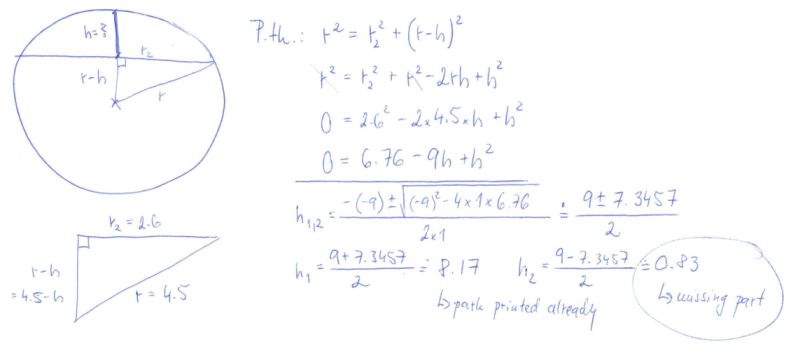My friend is an artist - an awesome one. Above all, he loves comics with his whole heart, he had even a comic book shop once. And he's going to re-open it again, soon - I believe.
So while being an excellent artist, he doesn't like maths, like many of my friends anyway... He can draw awesome pictures and create lots of unbelievable art stuff... so why to care about maths, when you can make your living by doing art, right?
Well, you'll be surprised...
When mathematician and artist met:
"Maths sucks!"
"Comics? Isn't it for kids only?"
"Maths sucks!"
"Well, those drawings are actually pretty cool..."
"I know, right? Maths sucks!"
"Draw me something, please - I really like it..."
"Yeah, no problem. Maths sucks!"
"Hey, it's really awesome, there's something in it - let's go see the new Marvel's movie"
"Yeah, let's go... Maths sucks!"
"That's an amazing statue you're creating, do you need a help with that proportion calculation?"
"Err, if you don't mind... (Maths sucks...)"
"Here are your calculations, it was my pleasure to help you with it - ask me anytime."
"Thank you. I might need some more if you don't mind? (But maths still sucks...)"
"Anytime... =)"
So what was it I've done so far for my artist friend?
A: Plane geometry
I don't know what was it for, but there was a circular base with a hole in the middle made of five identical parts. Given a radius, I was asked to find out the length of both the inner and outer arcs of those parts.
Well, that's pretty simple - if I divide a circle into five identical parts, every part will be a section worth 72° (as a whole circle is made of 360°), but in this case we actually already have the fraction on its own, so didn't need using the formula where "a desired angle/360°" appears, so simply use 1/5 as that's the part of the circumference we're looking for.
A circumference of a circle is calculated by a formula c = 2πr (where π could be 3.14 if you're ok with a rounded outcome, r is the radius). If you have just one-fifth of it, multiply the whole formula by 1/5.
As we had two concentric circles (that means both have the same centre and different radiuses), I got a radius of the outer one and knew how wide the base it should be, so by finding the difference I got radius of the inner circle and could use the same method to get answer for the length of the inner arc.
The best of it is, that the whole calculation depends on radius(es) only, so if you decide the base needs to be of a different size, just change the number for r, but still use c = (1/5)*2πr to get a fifth of circle's circumference.
B: 3D geometry
This one was actually pretty tricky as the first sight. Imagine you're printing a sphere on a 3D printer and you run of a material. So you got a part of it only, but instead of printing a new one, you decide to print just the missing bit. But how to get the dimension you need? The settings for the printer needed to input the height of the missing bit. Imagine it as if you have a part of a sphere and lay it on the table, how high would be the top of the partial-sphere?
For this bit you need a lot of imagination, or look at the sketch I made to visualize what am I looking for:

So we see there was a Pythagora's theorem used to find out a desired unknown, while knowing the radius of the original sphere (r) and measuring the radius of a flat surface (r2) where the sphere has been cut. By getting a quadratic equation, we need to use quadratic formula to find out roots, where we get when using r = 4.5 and r2 = 2.6 two outcomes h1 = 8.17 (height of the part printed already) and h2 = 0.83 (height of the missing part - the key number the printer needs to be able to print exactly the missing bit of the sphere). Just by checking you'll see that h1 and h2 together make the diameter of the original sphere.
C: Ratios
This time actually, my friend made his own calculations but wanted me to check if it's correct. It wouldn't be worth it to find out that the statue is disproportional and all the enormous amount of hours of work was for nothing...
So if you have a character and her weapon printed on a picture, you can measure the height of both of them. Let's say the character was 11 cm and the weapon (some sort of spear of what...) 7.5 cm.
You want to create the character of height 70 cm. But how about the dimensions of the weapon? Ratio ladies and gentlemen is the key. There are different way how to do it, my friend use one of them (correctly), I checked it this way:
Proportions of the weapon and the character must be same on a paper and in reality. Proportion (labeled "k") from measurement on the paper was weapon/character = 7.5/11 = 0.681818... - for our purpose rounding to 4 decimal numbers would be good enough, so k = 0.6818.
Proportions of a real statue and it's weapon is then w/ch = w/70 = 0.6818, after expressing w from this equation (by multiplying the equation by 70) we'll get w = 0.6818 * 70 = 47.726 cm as a real length of the weapon for a character of a height 70 cm. Tadaa...
So now tell me - do you need a maths when you're an artist? Certainly yes. (But yeah, yeah, maths sucks, I know...)



